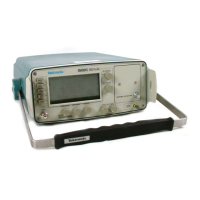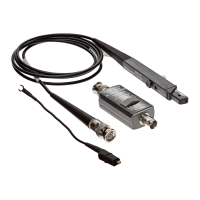Circuit Descriptions
1502C MTDR Service Manual
5–7
the current to continue flowing through CR2021 to filter capacitor C2025. Due to
its stored energy, the voltage developed across L2020 adds to the input voltage,
allowing C2025 to be charged to a voltage greater than the input.
The switching of Q2022 is controlled by pulse-width modulator U1023. The
post-regulator output voltage is fed back to U1023 through R1025 and R1024 and
compared to the +2.5 VDC reference from U1022. Low output voltage causes wider
pulses to be supplied to Q2022, storing more energy in L2020 during each pulse.
This results in a higher output voltage. High output voltage, however, reduces pulse
width and reverses the preceding process.
U1023 oscillates at approximately 80 kHz and supplies a synchronizing signal to
the pre-regulator at that frequency when the instrument is operating on AC power.
This raises the pre-regulator frequency to the same 80 kHz. This synchronization
eliminates beat frequency interference between the two regulators.
The synchronizing signal from U1023 is also supplied to Q2021, where it is
amplified to CMOS levels and buffered by gate U2030A. The signal is then used
to clock flip-flop U1024B to produce a 40 kHz square wave output at Q and Q
. These
square waves are buffered by other U2030 inverters and used to drive DC-to-DC
transistors Q2030 and Q2031.
Transistors Q2030 and Q2031 apply push-pull power to the primary of T1030 at
40 kHz by switching the +16.2 VDC alternately between the primary windings. The
resulting transformer secondary voltages are rectified and filtered by CR1034,
C1032, C1033, and C1034 to produce +15 VDC and –15 VDC. Other secondary
voltages are rectified and filtered by CR1030, CR1031, CR1032, CR1033, C1030,
C1031, and C1037 to produce +5 VDC and –5 VDC.
Diodes CR2031 and CR2030 rectify the primary voltage and clamp it to the voltage
level that is across C2031. This prevents voltage transients caused by the rapid
switching of Q2030 and Q2031 and prevents the leakage inductance of T1030’s
primary from creating excessive voltage stress. R2030 provides a discharge path
from C2031. T1031 and C1036 provide additional filtering of the +16 VDC supply.
Processor System
The processor system consists of the following:
H
Microprocessor
H
Address Decoding and Memory
H
Interrupt Logic
The processor system provides control and calculation functions for the instrument.
A block diagram of the processor system is shown in Figure 5–4 (next page).
DC-to-DC Converter
Introduction
Artisan Technology Group - Quality Instrumentation ... Guaranteed | (888) 88-SOURCE | www.artisantg.com

